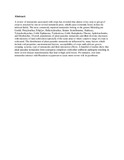Diversity and abundance of nematodes in agroecosystems of Kenya

View/
Date
2004Author
Kimenju, J W
Karanja, N K
Nyongesa, M W
Type
ArticleLanguage
enMetadata
Show full item recordAbstract
A review of nematodes associated with crops has revealed that almost every crop or group of crops is attacked by one or several nematode pests, which cause economic losses in heavily infested fields. The most commonly reported nematodes belong to the genera Meloidogyne Goeldi, Pratylenchus, Filip'jev, Helicotylenchus, Steiner Scutellonema, Andrassy, Tylenchorhynchus, Cobb Xiphinema, Trichodorus, Cobb, Radopholus Thorne, Aphelenchoides, and Ditylenchus. Overall, populations of plant parasitic nematodes and their diversity decreases with intensity of land cultivation especially if the same crop or where a narrow range of crops is cultivated. The distribution of plant parasitic nematodes is influenced by many factors which include soil properties, environmental factors, susceptibility of crops and cultivars grown, cropping systems, type of nematodes and their interactive effects. A handful of studies show that plant parasitic nematodes form synergistic complexes with other soilborne pathogens resulting in more severe disease manifestations that lead to high yield losses. For instance, root-knot nematodes interact with Fusarium oxysporum to cause more severe wilt in pyrethrum.
URI
http://www.ajol.info/index.php/jtmb/article/view/35425http://erepository.uonbi.ac.ke:8080/xmlui/handle/123456789/17153
Citation
Journal of Tropical Microbiology Vol.3 2004: 24-33Publisher
Department of Plant Science and Crop Protection, University of Nairobi
Description
Journal article
